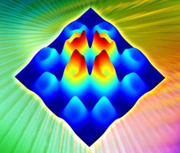- Number 305 |
- February 15, 2010
Neutron studies support superconductor theory

A simulation of the nature of the
spin excitations in a
superconducting material's
structure. Studies performed at
DOE's Oak Ridge National
Laboratory support theories that
magnetic properties play an
important role in high-temperature
superconductivity.
Neutron scattering experiments performed at DOE's Oak Ridge National Laboratory give strong evidence that, if superconductivity is related to a material's magnetic properties, the same mechanisms are behind both copper-based high-temperature superconductors and the newly discovered iron-based superconductors.
"The pairing up of electrons is essential for the formation of the macroscopic quantum state giving rise to superconductivity," said lead researcher Mark Lumsden of ORNL. "One of the leading proposals for the pairing mechanism in the iron-based superconductors is that magnetic interactions, provide the glue that binds the electrons together."
The ORNL researchers subjected single crystals of an iron, tellurium and selenium material to neutron scattering analysis at the SNS, HFIR and England's ISIS.
"Even in comparison to cuprates, this is experimentally the best indication of what the spin excitations are doing. One of the prominent views is that spin excitations are a key ingredient. The first step in evaluating this proposal is understanding what the spin excitations are and what they are doing," Lumsden said.[Bill Cabage, 865.574.4399,
cabagewh@ornl.gov]
